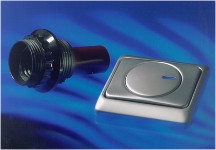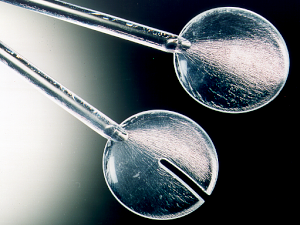2.3 Plastics
Properties of plastics:
- Electrical insulators
- Thermal insulators
- Some are flexible, some have high strength and are brittle
- Limited thermal loads
- Varied areas of application (e.g. packaging, tubes/hoses, light switches, electronic housings)
- A special feature of plastics is that their technical properties (e.g. ability to be shaped, hardness, elasticity, fracture strength, thermal stability and chemical stability) can be varied over wide limits by careful choice of the starting materials, manufacturing methods and the addition of additives.
- In general, plastics are:
- thermal and electrical insulators
- some are very flexible
- limited thermal stability
Classes of plastics:
The mechanical and thermal properties of plastics are commonly used to distinguish three classes of plastics.
| Thermoplastics | Thermosets | Elastomers |
|---|---|---|
 |
 |
 |
Source: Fraunhofer IFAM
Classes of plastics: Properties
Thermoplastics:
On being heated, thermoplastics first become soft and mouldable and finally melt. As these effects are reversible, they are utilised to give these plastics any desired shape.
Properties: Can be melted, can be welded, can be swollen, soluble, tend to undergo creep
Examples: PP (polypropylene), PE (polyethylene)
Thermosets are brittle, very strong plastics that also have good thermal stability.
Properties: Cannot be melted, cannot be welded, minimal swelling, insoluble, thermal stability under load, no tendency to undergo creep
Examples: Melamine-formaldehyde resin, epoxide, Bakelite
Elastomers:
Pressure or stretching forces cause elastomers to change their shape. Elastomers return to their original shape after removing the pressure or stretching force.
Properties: Cannot be melted, cannot be welded, can be swollen, insoluble, high tendency to undergo creep
Examples: Natural rubber, polyurethane, silicone
Bonding properties of plastics
The bonding properties of different plastics vary widely. For this reason, trial bonded joints should be manufactured and tested. If necessary, a suitable surface treatment procedure (see the section on surface treatment) should be carried out.
Factors affecting the bonding properties
- Additives
- Previous processing steps (e.g. steps that lead to formation of an injection moulding skin that is very difficult to bond)
Additives in plastics:
Additives are added to plastics to alter specific properties. However, some additives can adversely affect the bonding properties.
- Plasticisers
- (improve the forming/shaping properties)
- Lubricants
- (prevent friction during processing)
- Slip agents
- (enhance the surface slip properties)
- Release agents
- (aid removal from moulds and prevent stacks of products sticking together)
- Antistatic agents
- (prevent the build up of static charge)
- Stabilisers
- (improve the resistance to oxidation, hydrolysis, UV radiation, heat, fire)
Stress cracking in plastics
Under certain conditions, spontaneous cracks, so-called stress cracks, can occur in plastics.

Source: Fraunhofer IFAM
Stress cracking is a special feature of thermoplastics. Not all thermoplastics are prone to stress cracking to the same extent. Some plastics are more prone than others.
The media which trigger stress cracking also vary from plastic to plastic.
Stress cracking in plastics
- Stress cracking arises due to the simultaneous action of stresses and a stress crack promoting medium. Stress cracking mostly arises in thermoplastics.
- Spontaneous, non-predictable cracking
- First of all, small hairline cracks become visible on the surface via light reflection.
- Continuing stress leads to growth of these hairline cracks into bigger cracks and eventually to fracture.
Stress crack promoting media:
– The media which promote stress cracking depend on the respective plastic. –
Possible stress crack promoting media:
- Solvents, including those used for fine-cleaning (e. g. alcohols such as isopropanol)
- Surfactants in aqueous cleaning agents
- Adhesives (e.g. the hardener component of epoxides, components of MMA adhesives)
- Primers
Stress cracking is promoted by amongst other things:
- High tensile stresses
- High internal and cooling stresses
- Long duration of action of the stress cracking promoting medium
- High temperatures
- Mechanical surface pretreatment (→ stress)



